- You were born in Ichinomiya City in Japan’s Aichi Prefecture and we hear that your family ran a rental book shop.
- That’s right. Our shop had a lot of manga comic books and rental books, the kind of popular novels that people would rent and return rather than buy, and I used to read a lot of different things like the mangas by Shigeru Mizuki and Shigeru Sugiura and stories by artists like Shigeru Komatsuzaki. My father ran the rental book shop for about ten years when he was recovering from tuberculosis, and when he got well again he returned to work at his former company when I was about nine. These were memories I had until that time.
- We hear that you wanted to become a manga artist. Did you ever actually submit any of your work to a magazine?
- No. I wanted to but I was never able to put things together as one comprehensive work. And it is still the same with me today.
- When I watch the performances of your theater company Shonen-oja-kan I can understand it when you say you were influenced by authors like Taruho Inagaki (active from 1920s to ’70s, representative works: Issenichibyo Monogatari, Shounen-ai no Bigaku), Ouji Suzuki (b. 1949, manga artist/writer, representative works: Match Ippon Monogatari (1998), Koku Monogatari (2004)) and the GARO (monthly manga magazine (1964 – 2004), founded and edited by Shoichi Nagai) manga series that you say you liked.
- The influence of the GARO manga series was especially big for me. What I came to like about Ouji Suzuki was his use of line and the sense of anticipation for something or some unknown presence. I have said that I like Taruho Inagaki, but I haven’t actually read a lot of his works. In the end, what I like most is not so much the prose but the way the written characters of the Japanese language themselves represent not only Japanese words but also something akin to objet art. In short, I like the way that each individual written character stands alone with a powerful presence.
I truly admire the way Taruho Inagaki expresses what he calls a “universal nostalgia”—in short a nostalgia that seems to be on a vector that is neither toward the future or the past or for the present. That is an underlying sense that I also find in Ouji Suzuki’s mangas and in the songs of Morio Agata (b. 1948, singer-songwriter, movie director, actor) and it is that kind of thing that I admire and that I have a strong desire to be able to express in my own self and my work. For example, a feeling like when you got lost as a child. Distinct but unfathomable feelings like, “Where am I,” or, “What am I;” it is those kinds of feeling that I feel are connected to the origins of the fundamental nostalgia people feel.
When I was about a 6th-grader I read some of Shinich Hoshino’s short-short stories and they were really interesting for me. It was in the Shincho Bunko paperback literature series, and I read them because in the catalog Taruho Inagaki called Hoshino the “father of short-short stories,” but when I read them they weren’t short at all [laughs]. In Inagaki’s book Issenichibyo Monogatari (One Thousand and One Second Stories) I did find some of that aspect, but there was no punch line at the end of the stories. But as I read on, in an essay titled Bi no Hakanasa (The Vanity of Beauty) I found the expression “universal nostalgia” (uchu-teki kyoshu). I was surprised to find it the perfect expression for the “distinct but unfathomable feelings” I had felt from childhood but had never been able to put into words. Later, when I was able to talk with the folksinger Agata-san, he told me that he too had long admired Taruho Inagaki. And that made me think that this was definitely a point we had in common. - Besides his works, don’t you find the name Taruho itself fascinating?
- The very name “Taruho” itself definitely has a sound with indescribable impact. And in addition to the sound, the two characters of the name have a strange visual allure, like an objet art object, don’t they?
- What was it that first got you involved in theater?
- I used to dislike theater, but when I was 19 a classmate of mine from high school who had gone to a different college from mine joined the drama club and began doing theater, and when he started a new theater group called Benijujisha he asked me if I would do a leaflet and some stage art for them. And he said that I should also play an acting part in the production as well. So, even though I knew there was no way I could act well, there I was performing on stage, and of course I couldn’t do anything as an actor. But that failure disturbed me enough to get me involved in theater to prove myself, and before long the people around me were encouraging me to try my hand at scriptwriting. When my first attempt didn’t go well, I became determined to do better on my next try, and that became a kind of motivation for me in those early days of mine in theater. Eventually, it was that sort of, “I’ll do better next time,” attitude that got me to where I am today [laughs].
It could be that there was never any real reason for me to quit, but looking at it all from the inside I began to see a great amount of potential in doing theater. As I was doing it, I also had a vague idea that I wanted to make movies too, but I began to feel an increasing amount of possibility in theater as a performance medium with potential to create composite art that succeeds in bringing together live acting, lighting and music in one creative process. But even as I began to harbor the vague idea that this is what I wanted to do, none of what I did turned out to be really successful by any standard, so I always had the feeling in those early attempts that I could do more if I stuck with it. - The venue for those first productions of yours was the Nanatsudera Kyodo Studio (theater founded 1972 in Nagoya, seating capacity of 90) in Nagoya, which became your home ground.
- Yes. I feel it was there that I got my start as a theater maker.
- Nanatsudera Kyodo Studio stood along with Kyoto University’s Seibukodo facility as a base of underground theater. I have heard that the first time you went to Nanatsudera to see a play you mistakenly went up to the dressing room on the 2nd floor instead of the audience seating and stage on the first 1st floor.
- When I went in the entrance there was set of stairs right there, so I thought the audience seating was on the 2nd floor and I went right up. At the top of the stairs was the facility’s kitchen space, all full of the nitty-gritty of daily life, and at first I thought that was the stage area, and I said to myself, “Wow, this is what theater is like?” [laughs] The actors were there preparing for the performance and there was the strong smell of whitewash makeup; it was quite a shock for me. The feeling was something like being lost in a maze. That is the kind of feeling I think anyone must have the first time.
- Nanatsudera Kyodo Studio was a public theater, as the name “Kyodo” implies, and at first it was not only used for theater performances but also for movie showings, music and political activities and well as literature gatherings. But because each group has their own opinions, they can never really function together. And in the end, it was theater alone that it remained in use for.
- That’s right. And that’s why so many things were stored there. It was a real jumble of things everywhere, not really a mixing pot, but something close to that. The representative in charge of running the place, Toshiyuki Futamura (present adviser), didn’t keep strict rules. Not being “strict” like that is the most important thing, and I think it was good that things didn’t go in just one direction as a result. Because I was in charge of keeping an eye on things when no one else was there, and I was called the boss of the house-sitters.
- Nagoya is the only place in Japan that had a public studio like that and I think the best thing was that it was a facility that didn’t belong to anyone. Right next to it there was also a public bath, and there was a used clothes shop and a coffee shop there too, and anyone could sleep there.
- It wasn’t until recently that they started locking the doors when no one was there. Before, anyone could go in anytime. There were people staying there and managing the place who didn’t even have a formal contract for it [laughs].
- Because it was like that, Nanatsudera Kyodo Studio became an incubator that produced a lot of people involved in creating different kinds of artistic expression, and I believe you were one of them. When you formed your company Shonen-oja-kan at that time, did you have any clear vision of the kind of artistic expression you wanted to do?
- Even today I still don’t have a clear vision like that, but I have always had the same vague vision of the direction I want to work in. I want to surprise, or I want to do something strange. And, you could say I want to always be thinking about why this world exists like this, and in the end, it is a question of what I get glimpses of as I am working.
- In your directing, you often used shoji, the sliding papered doors/room dividers in Japanese home, in your early works like Go-Shimai (Sisters, 1988). The shoji is something that can be easily and quickly opened or closed, and things can burst through them. You just spoke a moment ago about the origins of the fundamental nostalgia, and seeing shoji gives us that kind of fleeting feeling of nostalgia, as if remembering when you got scolded for playing like that with it as a child.
- Because I always want to compile a lot of different elements into what happens on stage, it is hard to state it one word, but the main reason I often used shoji is that it enables you to do a variety of things like changing the scene in an instant, or you can change front for back easily.
- Besides simply enabling scene changes, or as a device that makes it possible for props to disappear, it can produce feelings similar to a flashback in the movies.
- I think that is closer to it. For example, if you think of time as only a concept, and if you can play around with things that you don’t if they really exist or not and do it in an extra-ordinary setting outside of the everyday, that is what I am most interested in. You can add things or take things away, turn things completely upside-down, speed them up or slow them down and also do it so people can experience it as a lie or a virtual experience, it can be very interesting to play with “the concept that is time.”
- In your recent works, you do things like suddenly turning on the lights in the audience or having the announcement for the audience to turn off their cell phones stop in the middle and have the voices of the actors in the play begin to broadcast on top of it, don’t you?
- I want to blur the moment of something “beginning.” I have the feeling that I want to blur the underlying form or perception that things are based on. A play is based on the assumption that it begins at one point and then comes to an end. That is what I have to blur a bit. It is enough to do that kind of thing once, but in my case it is something that I keep doing repeatedly with different methods and devices. It may sound like an overly grand statement, but I am always thinking about where this “me” came from. One can think in terms like the sperm and the egg, but then I think about where this phenomenon that is “me” came from. You can speak with a sense of things appearing from nothingness and eventually returning to nothingness, but what does it mean, and what is the significance of the phenomenon we call a play beginning and then ending. What is the state before it begins and what happens after it ends? This is what I am interested in. That is why I want to blur the beginning and why I want to also blur the ending. If doing that can create a connection between the beginning and end and thus create a circular state, what will happen? Like a snake swallowing its own tail, I want to create a form of theater where the beginning gradually erodes the ending, and I have been working hard toward that goal, but it is difficult and I haven’t succeeded at it yet.
- Another device you have used that seems to me to be very typical of your directing approach is to project (video) images of an actor on the actor him/herself as they stand on stage.
- From around 1990 when it first became possible to use video images in theater, everyone thought that video had to be projected on a screen, but in my case I started using it more a lighting or light than as video images. It’s the same now; I have always thought of everything on the stage as a screen equivalent when I direct. Now it is a method that they call “projection mapping” but back then no one else was using it that way.
- There are some directors that use video images a lot, but in most cases they are just using it to create the backdrop for a scene.
- There is nothing interesting about that. That is adding anything to the stage, it is just adding meaningless clutter, so it isn’t necessary. If you don’t work it in more so that it becomes an integrated part of the stage, it is meaningless. It comes from a belief in complete equality; in other words the belief that everything is equal in value. And that can perhaps lead to an interesting new question of differences in the level of equality between things.
- In an interview before one of your Shonen-oja-kan company productions you said, “My plays don’t have a storyline. They have time that can at times be objective or subjective, time that can circulate or stagnate, jump forward or reverse direction or flow back on itself.”
- That was probably at a time when I wasn’t able to write a single line [laughs]. That was the only thing I could say because there probably wasn’t any content worth talking about. But even when I finally complete a work, that is still about all I can say. Since I want to do things that are hard to explain, I guess I just don’t know how to explain them. Eventually, you might say that I get enclosed in a circle of the inexplicable nature of what I do.
- As a director, you not only direct works you have written yourself for your company, but at other times you do other types of works, such as ones where you choose an existing work as your subject, or ones where you direct productions by other theater units. One of your representative works that was not done by your company is the work Kudan no Ken that you did for the KUDAN Project of two-person plays produced by Hideji Oguma and Satoru Jitsunashi. It takes as the subject the legendary half-human, half-bull/cow creature, Kudan.
- For that work I took the legendary Kudan as my subject and then I proceeded to pile on motifs that arose from that image you might say; at times adding, at other times subtracting, dividing or differentiating the motifs in the creative process. The KUDAN Project has the restriction that it had to be a two-person play. When there is a restriction like that it is easier to bring the work to completion. When I have been asked to do a project that has such requirements regarding the subject and style, etc. that the person wants, it gives me a starting point and ground that comes from outside myself, and for that reason you might say it is easier to get into the project and begin the creative process. In contrast, when it is a work for my own Shonen-oja-kan company and I can do anything I want, it takes forever to get the project off the ground and moving forward; I just can’t get started writing [laughs].
- The two characters that appear in your work Kudan no Ken are named Hitoshi and Taro, and the two names serve as a form of anagram, with Hitoshi being transformable to “hito to shi” (Japanese for man and death) or to “hito to ushi” (man and bull/cow), while Taro (Tauro) is transformable into “minotauros” (Minotaur).
- It is a process of giving words double or triple meanings, or taking the words apart and reforming them as different words or phrases. Part of it is that I want to give multiple meanings to one thing, or perhaps I should say I want to pack a variety of things into them.
- By the way, you are also an illustrator. When you write a script, is it a process like putting pictures into words? How, or in what form do you “output” your ideas?
- I don’t output either pictures or words readily at first, so I start by linking lines by a rhyming method where I take the last two syllables of one line to make a word starting with those two syllables to begin the next line, and in that way I create words and derive the next line. In short, I utilize a process based on the Japanese word game of shiritori (linking words by the last syllable). This automatic process forces out a progression of lines. Lately, I always use this process. The repetition of this process finally starts me writing. It is getting started that is always the hard part. When I am faced with a condition where I can write anything I want, I just can’t write anything. When the script is written by linking lines in this way, it is hard to read, but have written down all the necessary things like the positions of the actors and the props, so if the actors just recite what is written in the script, it all begins to come together.
- Do you design the visual aspects like the stage art and lighting based on the script?
- The ideas for the stage art and music and such are based on prior discussions, and then I let the artists in each specialty create them. I write out the instructions for the lighting and acoustics and set changes so the staff can carry it out on their own. When it comes time to install the set and lighting and all, I am usually still writing, so if I have all the necessary instructions prepared in detail so the work can be carried out without my having to go to the theater to supervise, I’m going to have trouble getting the writing done in time for the opening [laughs].
- When you are connecting lines by the shiritori process, do you deliberately work with an image of creating lines that bring an unexpected twist in meaning to the line before?
- No, I just connect them naturally. But there won’t be sustained interest if the lines lack connection, so I make sure they connect in terms of meaning. Naturally that includes aspects of what we normally think of as “conversation.” Of course it is interesting if there are times when unexpected twists occur, but that is not really important, because it will be on the level of “true and false” or “thesis and antithesis.”
- Hideki Noda also uses word play in his play, such as having words coming from the television get into the lines of the actors as they are as part of the play. That play of words occurs on the spatial and temporal vectors and thus expands the theatrical world of the play.
- Yes, yes, that’s the way it should be. It’s not interesting at all unless it’s connected to something. And it also has to be something that connects to it afterwards. If it is just unconnected wordplay it becomes superfluous and is not interesting at all.
- When you spoke of Taruho Inagaki you talked about how his words appeared like objet art object, does that sense influence your theater works as well?
- If you can place words like a sort of object, in other words perceiving them as objects independent of the their linguistic meaning, they take on an equal value with the other things around them, don’t they. There is a sense that things with that kind of “equivalence” connect to everything else. If there are things that we perceive as being very far away and things that are close, we can feel that the distant things and the close things are connected; they are connected on a fundamental level, and that brings you a bit closer to a sense that they are connected in some aspect of appearance. Even if that isn’t easy for the audience to understand the connection, it is OK as long as they sense it.
- In other words, written letters (characters), meaning and light and everything else are all equal in value.
- That’s right. The moment that things that first appeared separate suddenly come together, we feel a light sense of elation. In other words, it is “the correspondence of all things” (the concept in mysticism that all the largest things in the world are mutually influenced by and reflect all the smallest things). This is the sense that I really want to realize. Even things that appear to have no connection at all in fact all correspond in some way. But this is only the case with things we conscious of, while the things we are not conscious of there is only a vague feeling of some kind of “setting.” Anyway, this is a good example of the difficulty of trying to explain things that can’t be expressed in words [laughs].
- Presently how many members are there in your Shonen-oja-kan company?
- There are about 20 actors, but not all of them are able to perform in each production. Since we rarely hold auditions, we choose new members little by little from among the people who see out performances and say they want to join us. At first we had stage staff members in the company, but now most of them have gone independent. Kazutoh Taoka, who has been doing stage art for us for many years is a former company member, with others staff members are not company members but work together with us as a team to some extent.
- Besides the performances around Japan, the KUDAN Project has taken its performances on tour in Asia (for details see Issue 28 of the international exchange magazine Wochi Kochi Magazine formerly published by the Japan Foundation). Where have you had overseas performances until now? (KUDAN Project producer and actor Hideji Oguma joined the interview here.)
- Oguma: Our first overseas performances were in Taipei, and after that we performed in Hong Kong, Beijing, Guangzhou, Harbin, Chongqing in China, Busan in the Republic of Korea, and in Manila, Kuala Lumpur, Bangko and in Indonesia, for a total off 10 cities and districts. Kudan no Ken premiered in Japan in 1995, but the performance in Taipei was the premiere of the KUDAN Project production after the partner change.
- With overseas performances there is always the language problem, and we hear that you didn’t use subtitles in translation.
- Amano
: In fact we did had prepared subtitles, but we agreed not to use them, no matter what. Instead we made hand-written cards with the lines we wanted to show in the local language so the actors could show them at the important moments.
Oguma : The cards were all made after we got to the overseas locations in the different countries, and as a result, in the two or three days it took to set up the stage and prepare for the performance, the resulting possibilities [for the performers and performance] multiplied by 50 to 100 times! [laughs]
Amano : We don’t know what things will be like until we get to the country where we will be performing, and I thought that there would not be anything interesting about just using a direct translation of the Japanese script. With the script translation cards you are interjecting something foreign into the stage action, but they can be used in a number of ways, such as to emphasize the words. It requires special skills, or a special quality in the actors, so it has to be a special actor like Oguma-san to do it successfully [laughs]. - It is something like the “speech/word bubble” or the “thought bubble” that is used on the pages of a manga comic, isn’t it? I think this is a theatrical invention on par with what Yukichi Matsumoto (the Ishinha founder and director known for outdoor theater) did by inventing the style of rhythmical delivery of spoken lines used by Ishinha that came to be called the “Janjan Opera” style because of its similarity to the Kecak dance of Bali.
-
Amano
: In order to make the script cards something more than just an annoying distraction, you have to find a way to integrate them into the play in a positive way that adds to the total effect, but on the contrary you could also capitalize on their distracting presence. In either case it requires a lot of technique, and since there aren’t many actors who can do this, I’m sure it will never become a popular practice.
Oguma : You can hide the card with your body, or you can place it on top of the card that the other actor has displayed, but in any event it requires actions that are not inherently part of the acting. A couple of times we have performed these overseas versions of the plays in Japan a “return” performances after a successful foreign tour.
Amano : We could also use script cards to do a different form of Japanese version. And the cards don’t have to have the same contents as the script but could be used to interject unexpected or contradictory contents. There are a lot of possibilities. - Since writers tend to have a strong attachment to the wording they have chosen, this creative use of script cards is not something that writers with that tendency could do or allow. Since it can also create unexpected or unintended effects, this is a style of play that can’t be unless you accept the process of breaking up the lines of the script you have written.
- That is also true. We first did an overseas tour last year with the Ryuzanji Company play Saiyuki (Journey to the West, 2015, written and directed by Amano)—and we are taking it to China this year—and that time we tried using script cards but it didn’t suit the actors. I found that indeed it required a special kind of actor to make it work. We used the cards to some extent in the first half, but then we stopped using them in the second half. So we ended up using projected subtitles and it turned out to be interesting, so I learned that subtitles are also a viable alternative [laughs].
- I wonder if the things we feel from what you present in your works that arouse nostalgia in the Japanese mind or bring back memories, and thus work on our subconscious, have the same effect on foreigners overseas?
- Since I am trying hard to appeal to the viewer’s archetypes, in other words because I am trying to create a state where different people will look at the same thing and it will stir completely different associations in each person, I am expressing things in sort of an abstract way. Because, the important thing is not the actual example but the state that lies behind it which is important. So, although it is not exactly a trance-like state, it is OK if the diversity of what each viewer sees is infinite in variety, and if there is some underlying state that serves as the origin, it can become a universal experience. Yukichi Matsumoto’s production Kani-denka (Crab Imperial Highness, 1984) was that kind of play with an underlying state of origin.
- The play Kani-denka that was performed at Osaka’s Nanko port back when Ishinha was still Nihon Ishinha was a prime example of multiple storylines unfolding simultaneously. The script was written with simultaneously occurring scenes and the dialogue was all connected in some way, and there wasn’t one stage but a situation where you had tunnels dug everywhere that characters suddenly appeared from.
- I was 24 when I saw that play, and until that time Matsumoto-san would do things like lining up actors in the nude and having them drink a n entire 1.8-liter bottle of water and then have them spit it all back up, thus showing that a human being is a cylinder, a single pipe-like container. Those 1.8-liter bottle were supposed to represent bottle of sake wine, but if you drank that much alcohol at one time it would kill you, so of course they were actually filled with water [laughs]. But I was deeply moved when I saw things like that. It was a crazy way to show it, but it was more directly effective than anything for posing the question, “What is a human being?”
- That kind of straightforward expression by Yukichi Matsumoto seems to be almost completely opposite from you own maze-like forms of expression, but I feel that the perspective from which you are looking at things is actually the same.
- me they are exactly the same. Like me, I believe for certain that Matsumoto-san essentially has the same obsession with such fundamental questions as what a human being is and what this world we live in is. The point of focus or the bundling point will of course be different, but for me, I believe I am doing the same thing he is.
- When you look at it in a photograph, Matsumoto-san’s form of expression is very eloquent, isn’t it? Kazuyuki Izutsu (Kazuo Izutsu at the time) filmed the documentary film about Nihon Ishinha titled Ashi no Ura kara Meiou made (1979), but I think that photographs speak more about Matsumoto’s work.
- Even today, the photographs seem more eloquent. Film isn’t necessary for things that are definitely destined to be legend. If you look at moving images there is nothing that sparks the imagination.
- Speaking of that, I think one could say that your works have an aspect something like photographic playback, couldn’t one?
- Yes. With motion pictures, if it wasn’t for the dark slit between each frame, it wouldn’t look like things are moving, and in the same way a dark pause comes every time we blink. There must be some difference in what we see before we blink and what we see after the blink, but the fact that we perceive it as a continuum is interesting. It would be interesting if something new suddenly appeared after that instant of darkness, and that is what I am doing in theater-making.
- That is why there is fast-forward and slow motion.
- And there is also the cutting out of still frames. We take an image that drops out of the film and then make it flow on naturally. It is fascinating to then think about how the cut-out image can be made into something interesting.
- But cut-backs, flashbacks and close-ups are difficult.
- Yes! Long ago when I had a one-on-one discussion with Matsumoto-san, we ended up talking about how it would be possible to do the equivalent of a close-up in theater. At first we were making grand statements about the question of subjectivity and human consciousness, but we were drinking as we talked and eventually it turned into foolish gibberish [laughs].
- Matsumoto-san also said he wondered if a shocking experience like the one that occurred in 1895 at the showing of movie titled “The Arrival of a Train at La Ciotat Station” when people seeing a motion picture for the first time screamed and ran for the exits as the life-size steam locomotive on the screen approached.
- Matsumoto-san’s eyes weren’t clouded. So he could see that film with the same eyes as people who were seeing a motion picture for the first time. The people and such in movies are so enormous and they have such awesome presence. It is actually a strange phenomenon that we are able to accept and enjoy then just as they appear. We have simply forgotten what at first should have been such an amazing experience. The most exciting thing is to be in a situation where we are remembering that initial experience.
- In recent year, you have been directing numerous puppet theater productions. Is this something that originated from your own interest in puppets? Or did you initially receive an offer to direct?
- Toshihiko Yamada of the ITO Project puppet theater company has always come to see our Shonen-oja-kan productions, and he came to me and said, “Let’s do something together.” Until then I had seen very little puppet theater but I thought there must be a lot of potential in it, so I was very interested.
- For the ITO Project productions, they make their own original puppets, so what kind of puppets, with what kinds of faces and shapes did you ask for?
- That’s right. The first production I worked on was titled Heitaro Bakemono Nikki (written, directed and with stage art by Tengai Amano based on the Edo Period record Inouenokeroku as first joint production with ITO Project, premiered 2004) and for almost all the puppets I drew a picture of what I wanted each puppet to look like. ITO is a company that specializes in the use of marionette puppets (puppets operated by stings), so I thought I would like to do things that can only be done with strings (ito in Japanese). More than just puppets, I wanted to concentrate the string aspects; in other words, to concentrate on the possibilities of puppets operated by strings. Just like in theater, where I want to do things that can only be done in theater, since I was given this opportunity, I wanted to do things that could only be done with puppets operated by strings. And the fun part was thinking about things that might not be possible to do with string operation, and I think that is also the most rewarding aspect. I don’t know much about the dynamics of string operation, so there is a black box aspect, and if I knew too much about string operation I wouldn’t be able to write things that seem impossible at first but turn out to be possible and stretch the limits of string operation, so I still try not to learn too much about it.
- What about Takaoka Shinnou Kokaiki (1992, written and directed by Tengai Amano for outdoor theater based on the original story by Tatsuhiko Shibusawa) that you staged this year the puppet play?
- With Heitaro Bakemono Nikki I had nearly used up all of my ideas for string operation, so I suggested things that might be impossible and I also asked the others if they had any good ideas. In that way, I created a production in collaboration with the people at ITO Project.
- When thinking about things that can’t be done with string operated marionette puppets, in comparison with live actors, is gravity the prime factor?
- Yes. Live actors can’t do it, but it is very easy to make marionette puppets float up into the air. So, I made lifting the puppets up into air something to avoid as much as possible in the usual way and tried to find ways to have the puppets rise up that would surprise and delight the viewers. By thinking about gravity, I realized what a difficult thing the act of walking is, how vital it is and how amazing it is. People who are using a marionette puppet for the first time can easily make it rise up, but it is impossible for them to make the puppet perform a natural walking motion. So, I decided not to include movements that the puppeteer could do easily, and instead I took a more stoic approach. Also, with puppets it is easy to make duplicates of the same type, but there is no interest in that. So, I searched for ways to make the appearance of the same type of puppet as surprising as possible.
The fact that it is a puppet can’t be hidden. When you start from the assumption, “But …,” it can lead to the birth of something akin to a meta-structure. - You also direct movies, and it seems that your approach is the same with movies: that you try to do things that can only be done in movies and you avoid doing things that can be done easily in the motion picture medium?
- Yes, Yes. Those are the possibilities and impossibilities I think of. Today, movies are also in the height of the computer graphics (CD) age, so it is easy to create anything. If I am going to do a movie I want to focus fully on the things that can only be done in movies—whether it is for the better or for the worse. Around the time I made the movie Twilights (1994, short film directed by Tengai Amano) we used film, so it was different from how movies are made today, but I still have the same feeling today about approaching film as a material on which the remains of light are exposed.
- Besides the KUDAN Project and the ITO Project, do you have any other artistic activities that you are engaged in regularly?
- Every year for about one month I go to Kumamoto to direct a production in residence at Amagasaya (a theater unity formed in Kumamoto in 2009). I am not a member of the company, but I was asked by a group of its members to direct for them when they attended my seminar I gave as an instructor for the “Theater College in Kumamoto” organized by the Japan Directors Association. Amagasaya is made up mainly of graduates of Kumamoto University who have their own companies but came together to be participate as the unit Amagasaya. Since it wasn’t possible for me to write a new play for them in the time I had, we decided to take apart a script or book of their choice and rearrange it as a new production that I would direct.
- Tadanori Yokoo is an artist and poster designer who was also a member of the former underground theater company Tenjo Sajiki, and he also did the posters for the company Jokyo Gekijo. When you look at his posters you can clearly see the difference between Tenjo Sajiki and Jokyo Gekijo, and you also know at a glance that they are works by Yokoo. There is something similar to that in your plays.
- I am very happy to hear you say that, I agree. I believe it is the result of the way I perceive essences, and I hope that doesn’t change.
- You design the leaflets and posters for your productions, and I wonder if you have a clear image in mind when you are creating the designs?
- No, I don’t [laughs]. I may have an image somewhere in my mind but it never comes to the surface when I am working on one.
- You use collage in your designs. It that something you decided on conceptually?
- I started using collage somewhere mid-career. Specifically, the first time I used collage was for the poster for the first joint production I did with Matsumoto san’s Nihon Ishinha, titled Shounen no Tama (1987). Before that, I didn’t have the money and color printing was expensive at the time, so I painted by hand. This November there will be a solo exhibition in Nagoya (15th to 30th November 2018, at Youki-soh in Kakiouzan, Nagoya) of my design work going back to the early days.
- When I look at those collages, I get the feeling that I’m peeking inside your head.
- You could call it a compilation of images, and you sat that is the same as surrealism. I make sure not to include any of my own will in them, and instead of painting or drawing anything with my own hand, I focus completely on grouping together things that other people have made in order to create something new. If my own will gets involved, that’s nothing of interest to me. The interesting thing is trying to completely rid it of my self.
- You speak often of “collective unconsciousness.” Is that what is expressed in your leaflets and posters?
- Well, yes. When I am writing a script, if it doesn’t produce some of that collective unconsciousness, I won’t fall behind, but when there is a deadline approaching and I am frustrated and just want to get something, anything complete, and when something comes to mind at that time that feels important to me, that feeling is very close to the process of making a collage for me. Rather than bringing something out from myself, I am bringing in things from outside that I have found and putting them together with happy mindlessness. The time I spend like that is true bliss [laughs].
- Like putting yourself in a state of collective unconsciousness….
- There is that kind of joy in it. When I am making collages, I feel that go though the process very naturally.
- So, you are not doing it in something like a trace but in a lucid state of mind. Because, theater is something that you simply cannot do without the input from other people, so you are expected to be lucid at all times.
- That’s right. Knowing what to do you do to keep a lucid state of mind at all times is very difficult. For example, even if you try to work people into a trance-like stay, you don’t know if it is going to happen or not, and working a to manipulate and control things by yourself is very hard to do.
- Next May, you will be performing your next Shonen-oja-kan company work at the New National Theatre, Tokyo.
- I don’t yet know what we are going to do, but I have intuitively chosen a title, which will be “1001.” It is the binary system, it is “something, nothing, nothing, something,” it is Taruho’s Issenichibyo Monogatari, and it is the Thousand and One Arabian Nights. I vaguely want to do something that takes a sort of quantum mechanics approach to things that generate around those themes and sprinkle it on everything and mix it all up. I think the title of 1001 is good, because anything I choose to come up with will fit under it.
- We hear that this will be the first time since Ishinha’s nocturne in 2003 that the New National Theatre, Tokyo will be sponsoring a program by a single theater company.
- Yes, that seems to be the case. But the difficult thing for me is that they are saying I can do anything I want. In contrast, if they told me, “We don’t want you to do such-and-such,” then I could see gaps to work into. It is not a matter of antagonism, but that would held motivate me and give me a hurdle I could work to clear.
Tengai Amano
Tengai Amano, an artist of the fantastic
Commanding a nostalgia for the universe
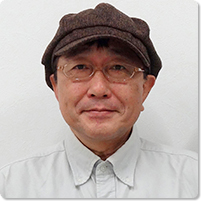
Tengai Amano
Born 1960 in Ichinomiya city, Aichi Prefecture. Amano is the leader, playwight and director of the theater company Shonen-oja-kan. After a period with the theater company Benijujisha, he started the company Gekidan Shonen-oja in 1982 (name changed to Shonen-oja-kan in 1985). With Amano as the writer and director of most of the works this Nagoya-based company performs nationwide in Japan. In 1992, he drew attention from various directions with his adaptation of Tatsuhiko Shibusawa’s Takaoka Shinnou Kokaiki for outdoor theater. In 1994, Amano directed his first short film Twilights which won the Grand Prize at two international film festivals (Germany’s 41st International Short Film Festival Oberhausen and Australia’s 44th Melbourne International Film Festival Short Film Division). Since 1998, Amano has directed for the KUDAN Project and simultaeously began giving overseas performances. In 2000, his play OSHIMAI – Kudan no Ken was nominated as a finalist for the 44th Kishida Drama Awards. In 2005, Amano drew attention with his production Hyakunin Shibai – Mayonaka no Yaji-san, Kita-san with more than 160 actors participating. Amano’s diverse artistic activities also include writing and directing for companies including Ryuzanji Company, ITO Project, Amagasaya and others. In May 2019, Amano will write and direct a new work titled “1001” at the New National Theatre, Tokyo.
Shonen-oja-kan
http://www.oujakan.jp/
In this long interview we search for the roots of Amano’s fantastic world that is the focus of increasing attention on Japan’s performing arts scene.
Interviewer: Jun Kobori; interview composition: Katsumi Mochizuki
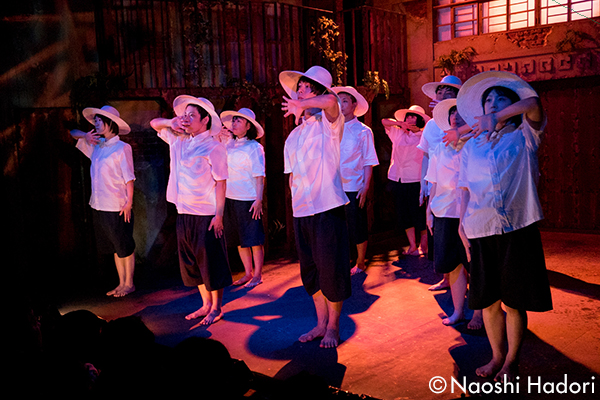
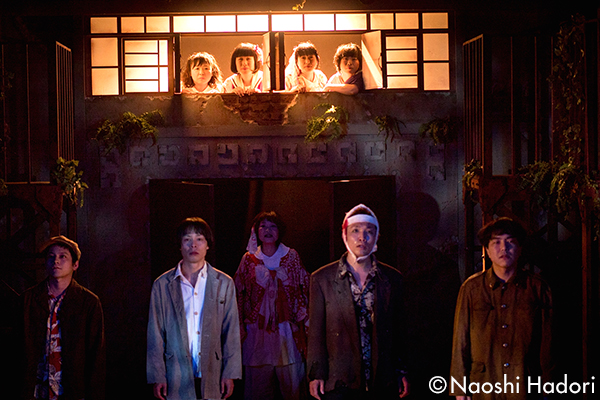
Shonen-oja-kan Omoidashi Mirai
(2016, written and directed by Tengai Amano)
Photo: Naoshi Hadori
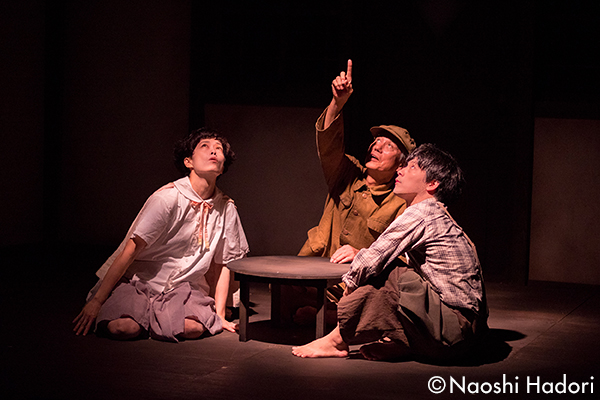
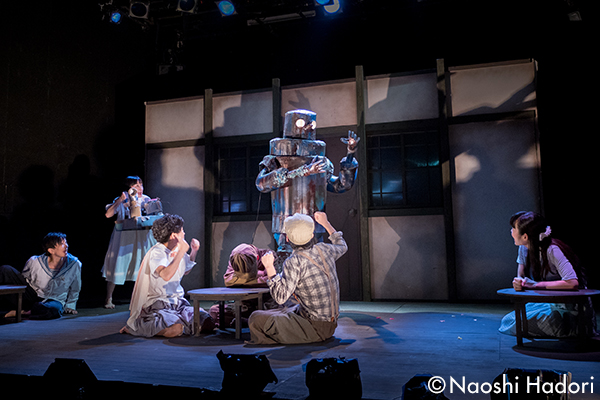
Shonen-oja-kan Cyan Garden
(2017, story by Kujira Koba, scripted and directed by Tengai Amano)
Photo: Naoshi Hadori
The marionette troupe isshiza Red Demon and Blue Demon
(2016, story by Hirosuke Hamada, scripted and directed by Tengai Amano)
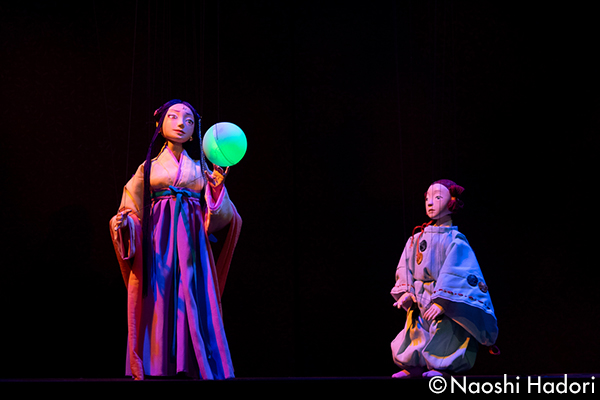
ITO Project Takaoka Shinnou Kokaiki
(2018, story by Tatsuhiko Shibusawa, scripted and directed by Tengai Amano)
Photo: Naoshi Hadori
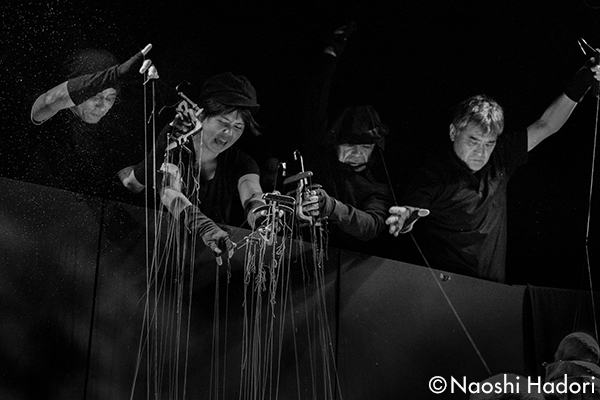
operation of Takaoka Shinnou Kokaiki
Photo: Naoshi Hadori
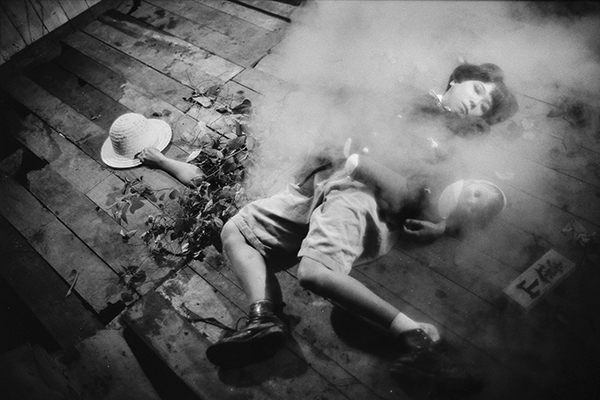
Twilights
(1994, director: Tengai Amano)
Related Tags

